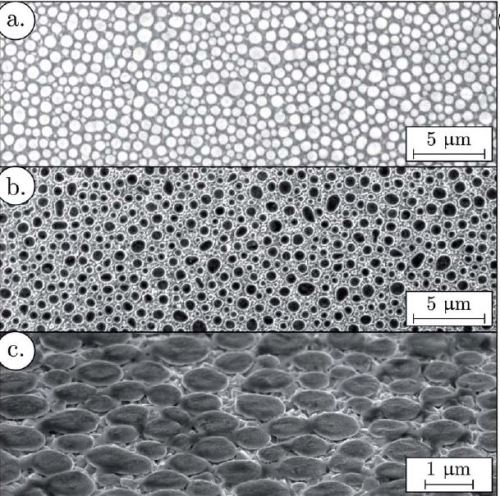Collecting light with artificial moth eyes

Ammonium tungstate/PSS film surface: (a) SEM picture before pyrolysis; (b & c) SEM picture after pyrolysis. © EMPA
Scientists at EMPA in Zürich and University of Basel have developed a photoelectrochemical cell, recreating a moth’s eye to drastically increase its light collecting efficiency. The cell is made of cheap raw materials – iron and tungsten oxide. Analyses at BESSY II have revealed which chemical processes are useful to facilitate the absorption of light.
Empa researchers Florent Boudoire and Artur Braun have implemented a special microstructure on the photoelectrode surface, which gathers sunlight and does not let it out again. The basis for this innovative structure are tiny particles of tungsten oxide. These yellow microspheres are applied to an electrode and then covered with an extremely thin layer of iron oxide. When light falls on the particles it is internally reflected back and forth, till finally all the light is absorbed. All the entire energy in the beam is now available to use for splitting the water molecules.
In principle the newly conceived microstructure functions like the eye of a moth, explains Florent Boudoire. The eyes of these night active creatures need to collect as much light as possible to see in the dark, and also must reflect as little as possible to avoid detection and being eaten by their enemies. The microstructure of their eyes especially adapted to the appropriate wavelength of light. Empa's photocells take advantage of the same effect.
The swiss team did analyze their samples under the x-ray microscope at BESSY II in order to get detailed information about the absorption of light and the chemical processes which enhance it.
Information of EMPA
Publication in Energy&Environmental Sciences
EMPA/arö
https://www.helmholtz-berlin.de/pubbin/news_seite?nid=14008;sprache=en
- Copy link
-
The twisted nanotubes that tell a story
In collaboration with scientists in Germany, EPFL researchers have demonstrated that the spiral geometry of tiny, twisted magnetic tubes can be leveraged to transmit data based on quasiparticles called magnons, rather than electrons.
-
Ernst Eckhard Koch Prize and Innovation Award on Synchrotron Radiation 2025
At the 27th BESSY@HZB User Meeting, the Friends of HZB honoured the dissertation of Dr Enggar Pramanto Wibowo (Friedrich-Alexander University Erlangen-Nuremberg). The Innovation Award on Synchrotron Radiation 2025 went to Prof. Tim Salditt (Georg-August-University Göttingen) and Professors Danny D. Jonigk and Maximilian Ackermann (both, University Hospital of RWTH Aachen University).
-
Bright prospects for tin perovskite solar cells
Perovskite solar cells are widely regarded as the next generation photovoltaic technology. However, they are not yet stable enough in the long term for widespread commercial use. One reason for this is migrating ions, which cause degradation of the semiconducting material over time. A team from HZB and the University of Potsdam has now investigated the ion density in four different, widely used perovskite compounds and discovered significant differences. Tin perovskite semiconductors produced with an alternative solvent had a particular low ion density — only one tenth that of lead perovskite semiconductors. This suggests that tin-based perovskites could be used to make solar cells that are not only really environmentally friendly but also very stable.
